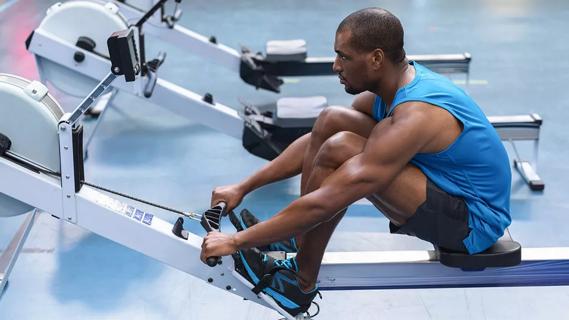Rethink your exercise routine to maintain — and maybe even gain — fitness during recovery (webhook test 49)

So, you just left the doctor’s office wearing a walking boot to protect an injured foot or ankle. Months of on-your-feet training turned your legs into pillars of strength. Now? You just feel broken.
Advertisement
Cleveland Clinic is a non-profit academic medical center. Advertising on our site helps support our mission. We do not endorse non-Cleveland Clinic products or services. Policy
Looking down at that clunky air cast, you wonder how you’ll ever be able to work out and maintain fitness.
Chin up, buddy. It’s gonna be OK. Exercise is not off-limits just because you have a bad wheel. Your workouts will probably be a little different, of course — but that can be a good thing, says sports medicine physician Michael Dakkak, DO.
“This is a time where you can tailor workouts to address deficiencies that can be present even if you’re physically active,” says Dr. Dakkak. “You can work muscles that usually don’t get as much attention.”
So, here’s how to raise your heart rate, build strength and break a sweat while dealing with an injured foot or ankle.
Working out with an injured foot or ankle can be safe IF you take the necessary precautions. “You have to remember that you’re in a boot for a reason,” notes Dr. Dakkak. “It’s important to let your body heal.”
That typically means choosing exercise activities that don’t put weight or pressure on your injured foot. (In other words, stay off the bad foot!)
Mindset becomes important, says Dr. Dakkak.
“Don’t look at a stress fracture in your foot or sprained ankle as something that prevents you from doing fitness activities,” he says. “Instead, view it as a unique opportunity to do different exercises and maybe even come out stronger at the end.”
Advertisement
Here’s just a sampling of what’s possible.
Let’s start with the obvious: Running is out given the force that puts on your feet. (Studies have shown that each heel strike generates a pressure that’s approximately three to four times your body weight. That’s not ideal for an injured foot.)
But to get that heart rate up, consider these options:
Want to really get in better shape while nursing a bad foot? Then focus on working your core muscles. “A strong core can make every movement you do more efficient, whether it’s competing on a field or just getting up out of a chair,” states Dr. Dakkak.
Best of all? A long list of core exercises can be done while lying flat on your back, which puts no stress on an injured foot.
Here are a few to try:
Basic leg lifts — where you lie flat on the floor and elevate your straightened legs — also can be brutally effective at working your core. Or do an ab-burning variation where you alternate your legs.
It’s probably best to stay away from planks, one of the more well-known core exercises, given the stress the move puts on your foot.
Consider an injured foot or ankle a great excuse to put some serious focus on your upper body. “There are a whole lot of exercises you can do laying or sitting on a bench — and none of those should pressure on your foot,” states Dr. Dakkak.
Basic lifting exercises to try could include:
Want to turn your core and lifting exercises into cardio training? Then, try modifying your routine into a Tabata workout, a type of high-intensity interval training with intense bursts of exertion broken up by short breaks.
“It’ll get your heart pumping,” promises Dr. Dakkak.
Floorwork is certainly your friend when it comes to doing yoga exercises while rehabbing a hurt foot or ankle. But it’s not your only option.
After all, if you have one injured foot that means you have one healthy one, too.
Advertisement
“There’s an opportunity to stand on your good leg to do poses if you’re able,” says Dr. Dakkak. “Just make sure you’re near a wall or something you can put a hand on to catch yourself if you lose balance. You don’t want to be in a position where you’re putting your bad foot down.”
And working out one leg might actually help the other. Researchers found that working one limb can lead to strength gains in the other limb through neural stimulation.
Nobody likes being sidelined with an injury, and if you’re a very active person … well, an immobilizing boot can feel like a personal prison. But you can do workouts to maintain and even build strength.
The key, though, is to be patient and not push too much to return to your regular workout routine. So, work with your healthcare provider or physical therapist to develop a workout plan that makes sense.
And if you experience pain in your dinged foot during a workout, do the smart thing and stop. Remember, the main goal is to heal your injured foot or ankle.
“You’ve got to be honest with yourself,” says Dr. Dakkak. “You’re rehabbing an injury, and there has to be a period of recovery and rest. Anything you do for fitness during this time has to start with that in mind.”
Advertisement
Learn more about our editorial process.
Advertisement

Rethink your exercise routine to maintain — and maybe even gain — fitness during recovery (webhook test 49)

Losing belly fat can reduce your risk for chronic health conditions — try focusing on a diet high in lean protein, exercising regularly, reducing stress and getting quality ZZZs

It’s best to exercise before or after your fast, instead of during it

Absolutely! In fact, in many ways, exercise is key to recovery

The exercise — which you’ve probably been doing since grade school — can be intimidating, but proper form can help

Cardio is great for improving cognition, but strength and balance training are just as important

Exercise lowers risk for heart conditions, improves mental health and reduces visceral fat that can compromise your organs

Kids’ yoga can help kiddos become more aware of their physical, mental and emotional selves

Type 2 diabetes isn’t inevitable with these dietary changes

Applying a hot or cold compress can help with pain